
views
X
Research source
We’ve outlined the best techniques for using a massage gun whether you’re stiff from a long day in the car or sore from an intense workout. If you’re ready to kick back and relax, keep scrolling!
- Use a massage gun for 30 seconds before a workout to activate your muscles, or for 2 minutes afterward to prevent or reduce muscle soreness.
- Target muscle groups and soft tissue with your massage gun while avoiding bony areas and joints like your spine, ankles, or elbows.
- Begin massaging on the lowest setting and work your way up to higher speeds as you get used to the intensity.
Use a massage gun on sore or stiff muscle groups.
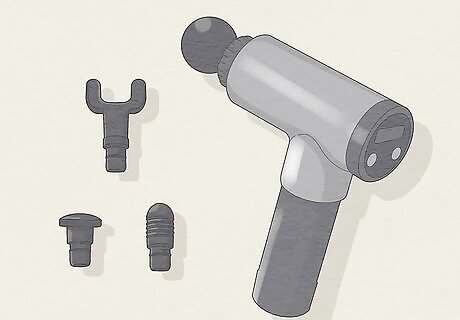
Massage guns are designed to safely soothe muscles and soft tissue. Target muscle groups that are sore after a workout or stiff from sitting at a desk. Make sure there are no cuts or bruises over these areas, and wait until any muscle or bone injuries are fully healed before using a massage gun over them. Avoid bony areas and joints like the spine, ankles, or elbows. The massager will rattle or bounce on these areas, causing discomfort and bruising. Massage guns are commonly used on lower body muscles (calves, quads, hamstrings, glutes), upper body muscles (biceps, triceps, pectorals), hands and feet, shoulder blades and lower neck, or on the back (minus the spine).
Attach a massage head for specific muscles or areas.
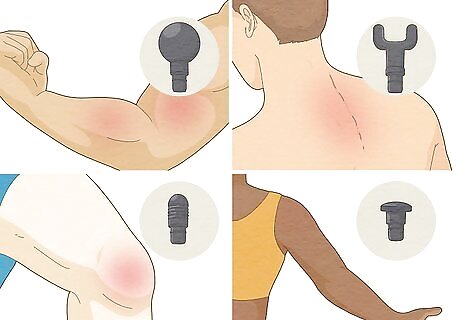
Most guns come with at least 4 attachments for different purposes. Make sure the gun is off before you swap attachments, then push or twist your preferred head into place before you turn it on. The most common and popular attachments are: Ball/spherical head: This is the standard and most versatile head. Use it for general deep tissue massaging on any muscle group. Fork/U-head: Use to target the muscles on either side of the spine (avoiding the bones) or in the feet and ankles. Bullet head: Attach the bullet head to target specific knots and tight spots or to massage trigger points. Flat head: Use this for the shoulder blades and IT bands, or for a relaxing full-body massage. It’s suitable to work small areas or large muscle groups.
Turn the massage gun on before placing it on your body.
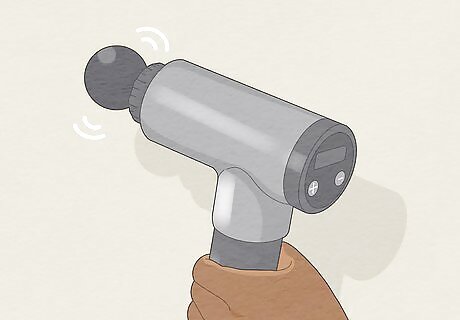
Starting the gun while it’s touching you can be jarring or painful. Always activate the gun away from your body to reduce the risk of injury. On most massage guns, press and hold the “On” button until the massage head starts percussing (moving up and down rapidly). If you’re using the gun on another person, tell them when you’re about to place it on their muscles so they can prepare for the sensation. Make sure the massage head attachment is secure before turning the gun on. Read your instructions manual for directions on how to turn on your specific model of massage gun.
Select the lowest intensity setting.
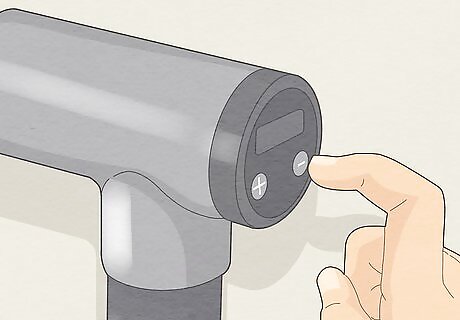
Start slow to allow your body and muscles to adjust to the pressure. If you begin too fast, your muscles can tense up and block the massager from reaching deeper tissue. As you get more comfortable with the pressure, cycle through stronger settings to reach the desired effect. Read the instructions for information on the various settings and how to switch between them. You’ll likely push the “On” button or use a set of arrow buttons.
Rest the massage head perpendicularly over your muscle.

Hold the massager so the head just grazes the skin over the muscle. Resist the urge to push the massager into your muscle—the up and down motion (amplitude) of the gun will do the work for you. Just float the massage head on the skin (or over a thin layer of clothing). Some massage guns will stall if you apply too much pressure during your session to prevent injury or bruising.
Glide the head all over each muscle for up to 2 minutes.

Move vertically, horizontally, or in circles to massage the muscle. Start by covering the entire muscle or area with light to moderate pressure. Rest the gun on specific tight areas for 1-2 minutes to get rid of knots. If your muscle is particularly dense, apply a little bit of pressure. Back: Massage the bulky muscles on either side of the spine in up-and-down motions with the flat head. Add some side-to-side motion near the spine. Glutes, thighs, calves: Glide the massager up and down along the length of the muscles. Try the fork attachment to reach more muscle at once. Arms: Use the ball head and glide up and down along the length of your biceps, triceps, or forearms, then move side to side across them. There’s no “correct” way to massage sore muscles. Do whatever feels good for your body, making sure not to target one muscle group for more than 2 minutes. A little discomfort is OK, but stop the gun if you feel true pain. If someone is using a massage gun on you, speak up if you feel pain.
Activate muscles for 30 seconds before a workout.

Massage the areas you plan to exercise to warm up your muscles. Combine a quick massage gun session with stretching and cardio to increase blood flow to your muscles and improve mobility. Just rest the massager on the areas you want to work out for 30-60 seconds before you begin exercising. If your muscles feel tense, tight, or exhausted during your workout, massage them for about 15 seconds to reactivate them.
Massage muscles for 1 minute after a workout to cool down.
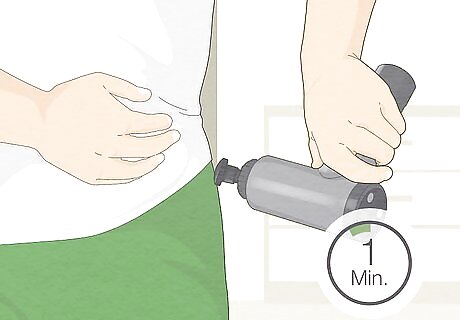
Use the massage gun to reduce inflammation and prevent soreness. Right after your workout, massage the muscles you targeted for 1 minute to maintain blood flow—this keeps oxygen and nutrients flowing to your muscles, which relaxes them and reduces inflammation. In addition to massaging, remember to drink water and stretch your muscles to recover from your workout. If your muscles hurt post-workout, massage them on a low setting for up to 2 minutes each for temporary pain relief and increased mobility. If you strained or injured a muscle, wait a few days before using a massage gun to let your body partially recover. The massager might worsen the injury.
Massage stiff muscles for up to 2 minutes for relaxation.

Massage anywhere you feel tension, even if it’s not exercise-related. Try a full-body massage when you wake up to improve mobility and muscle movement, or before bedtime for deep relaxation that might help you sleep. Use it anywhere you like to relax after a long day, too. If you have “tech neck” (stiff neck and shoulders) from sitting all day, massage the back of your neck and shoulders on low speed with the ball head.
Apply ice or heat treatments after your massages.

Ice and heat are optional, but help further soothe and relax muscles. If you have an acute pain, ice the sore area to reduce inflammation and pain. For broader soreness, apply heat to relieve muscle stiffness and increase mobility. If you just want to generally relax your muscles, apply heat after your massage gun session. To apply ice, place an ice pack over the sore spot for up to 20 minutes at a time. Wrap the pack in a cloth or place it over clothing to protect your skin. To apply heat, take a warm bath or shower or use a heating pad for up to 20 minutes at a time.













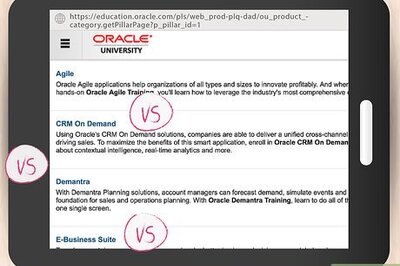



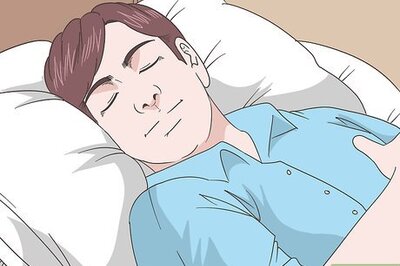
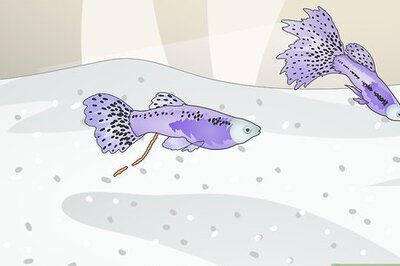
Comments
0 comment